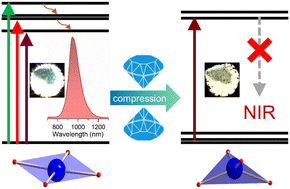Piezochromism and anomalous near-infrared luminescence evolution of BaCuSi4O10 and BaCuSi2O6via pressure-induced phase transition†
Abstract
The inorganic pigments BaCuSi4O10 (Han blue) and BaCuSi2O6 (Han purple) possess a bright hue in a square-plane [CuO4]6− chromophore, which also gives intense and broad emission in the near-infrared (NIR) region. In this paper, we utilize the pressure technique to explore the evolution of the color and the NIR luminescence from the crystal-field of the [CuO4]6− chromophore in BaCuSi4O10 and BaCuSi2O6. The absorption and NIR emission spectra of BaCuSi4O10 show sudden changes at the phase transition points (∼3 GPa and 15 GPa), where the square coordination of Cu2+ evolves into over-bonded and then tetrahedra, along with the space group alternation from P4/ncc to P4212 and finally to P21212. In contrast, the NIR emission from BaCuSi2O6 weakens constantly upon compression up to 15 GPa, accompanied by piezochromism from blue to green, which aligns with the transformation of Cu2+ coordination from square-planar to tetrahedron. Our study contributes to the understanding of the behavior of these ancient pigments under extreme conditions and further offers insights into the regulation of photophysical properties through pressure-driven Cu2+ crystal fields.

- This article is part of the themed collection: 2023 Journal of Materials Chemistry C HOT Papers


 Please wait while we load your content...
Please wait while we load your content...